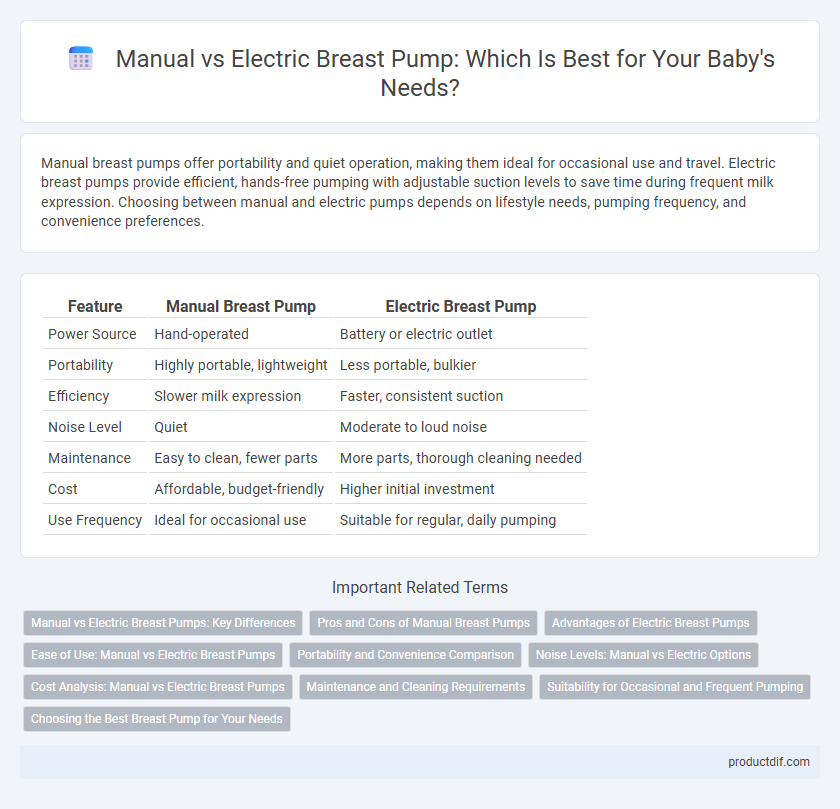Manual breast pumps offer portability and quiet operation, making them ideal for occasional use and travel. Electric breast pumps provide efficient, hands-free pumping with adjustable suction levels to save time during frequent milk expression. Choosing between manual and electric pumps depends on lifestyle needs, pumping frequency, and convenience preferences.
Table of Comparison
| Feature | Manual Breast Pump | Electric Breast Pump |
|---|---|---|
| Power Source | Hand-operated | Battery or electric outlet |
| Portability | Highly portable, lightweight | Less portable, bulkier |
| Efficiency | Slower milk expression | Faster, consistent suction |
| Noise Level | Quiet | Moderate to loud noise |
| Maintenance | Easy to clean, fewer parts | More parts, thorough cleaning needed |
| Cost | Affordable, budget-friendly | Higher initial investment |
| Use Frequency | Ideal for occasional use | Suitable for regular, daily pumping |
Manual vs Electric Breast Pumps: Key Differences
Manual breast pumps are typically lightweight, portable, and quieter, making them ideal for occasional use and travel, while electric breast pumps offer faster, more efficient milk expression through powered suction, suitable for regular or frequent pumping. Electric pumps often feature adjustable settings and double-pumping capabilities, enabling mothers to express milk from both breasts simultaneously, which can save time and increase milk supply. Manual pumps are more affordable and require no electricity, but electric pumps provide consistent suction and speed, offering greater convenience and comfort for long-term use.
Pros and Cons of Manual Breast Pumps
Manual breast pumps offer portability and quiet operation, making them ideal for travel and discreet use. They require no electricity, reducing cost and allowing flexibility in any environment, but the hand operation can cause fatigue during extended use. Manual pumps typically have fewer parts, making cleaning easier, though they may not provide the same suction strength and efficiency as electric models.
Advantages of Electric Breast Pumps
Electric breast pumps offer significant time-saving benefits by efficiently extracting milk with minimal effort, making them ideal for busy mothers. Their adjustable suction settings provide personalized comfort and improved milk flow compared to manual pumps. Many electric models also feature dual pumping options, which enhance milk output and reduce pumping duration.
Ease of Use: Manual vs Electric Breast Pumps
Manual breast pumps offer simplicity and portability, making them easy to use without requiring power sources, which is ideal for occasional use or travel. Electric breast pumps provide automated suction with adjustable settings, allowing for more efficient and hands-free operation, especially beneficial for frequent pumping sessions. Choosing between manual and electric depends on convenience preferences, pumping frequency, and ease of handling for new mothers.
Portability and Convenience Comparison
Manual breast pumps offer superior portability due to their lightweight, compact design and lack of reliance on batteries or power sources, making them ideal for on-the-go use and travel. Electric breast pumps provide greater convenience with faster expression times and adjustable suction levels, but their bulkier size and dependence on electricity or charged batteries can limit mobility. Parents often choose manual pumps for ease of transport, while electric pumps suit those needing efficient, hands-free operation during regular pumping sessions.
Noise Levels: Manual vs Electric Options
Manual breast pumps operate quietly, producing minimal noise since they rely solely on hand motion, making them ideal for discreet use in quiet environments. Electric breast pumps tend to be louder due to motorized suction mechanisms, which can range from low hums to louder mechanical sounds depending on the model and suction strength. Noise levels are a crucial consideration for mothers seeking privacy and comfort during pumping sessions, especially in shared or public spaces.
Cost Analysis: Manual vs Electric Breast Pumps
Manual breast pumps typically cost between $15 and $60, making them a budget-friendly option for many mothers. Electric breast pumps range from $100 to $300 or more, often offering faster and more efficient milk extraction. When evaluating cost, manual pumps have lower upfront expenses but may require more effort and time compared to electric models, which justify higher prices through convenience and advanced features.
Maintenance and Cleaning Requirements
Manual breast pumps offer simpler maintenance with fewer parts to clean, making them easier to sterilize and assemble, ideal for quick and frequent use. Electric breast pumps require more thorough cleaning due to multiple components including motorized parts and tubing, which may harbor milk residue and bacteria if not properly sanitized. Regular disassembly and cleaning following manufacturer guidelines are crucial for both types to ensure hygiene and extend product lifespan.
Suitability for Occasional and Frequent Pumping
Manual breast pumps are ideal for occasional use, providing portability, quiet operation, and easy cleaning, which suits mothers who need to pump infrequently or on-the-go. Electric breast pumps offer efficient, hands-free pumping with adjustable suction levels, making them better suited for frequent or exclusive pumping needs by saving time and increasing milk output. Choosing between manual and electric pumps depends on the mother's pumping schedule, lifestyle, and desired convenience.
Choosing the Best Breast Pump for Your Needs
Manual breast pumps offer portability and quiet operation, making them ideal for occasional use and travel, while electric breast pumps provide faster, more efficient milk expression suited for regular or high-volume pumping. Factors such as frequency of use, budget, ease of cleaning, and comfort should guide the choice; electric pumps often feature adjustable suction and speed settings for personalized experience. Selecting the best breast pump involves assessing your lifestyle needs, ensuring compatibility with your breastfeeding goals, and prioritizing features that enhance convenience and milk output.
Manual vs Electric Breast Pump Infographic

 productdif.com
productdif.com